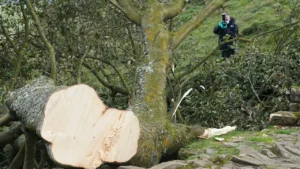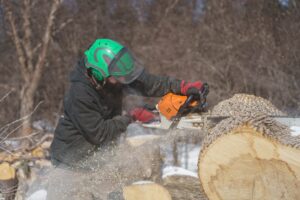Tree Removal in the United Kingdom: Laws, Permits, Application & Cost
Tree removal in the United Kingdom involves navigating a complex system of regulations designed to protect the nation’s green heritage while balancing property owners’ rights. Whether you’re planning landscaping changes, addressing safety concerns, or managing diseased trees on your property, understanding the legal framework is essential before you take action.
Understanding Tree Protection in the UK
Trees contribute significantly to the UK’s environmental health, providing habitat for wildlife, improving air quality, and enhancing landscape aesthetics. Because of their importance, various legal protections exist to prevent unnecessary removal. Even on your own property, you don’t have unlimited rights to remove trees at will.
The primary protections for trees in the UK come through Tree Preservation Orders (TPOs), Conservation Areas, felling licenses, and planning conditions. These regulations vary by region and local authority, making it crucial to research your specific area’s requirements before proceeding with any tree removal.
Tree Preservation Orders (TPOs)
Tree Preservation Orders constitute the strongest form of protection for individual trees or groups of trees in the UK. Local planning authorities issue TPOs to protect trees with particular amenity, cultural, or environmental value.
If a tree on your property is covered by a TPO, you must obtain permission from your local council before undertaking any work, including:
- Cutting down the tree
- Topping or lopping branches
- Uprooting the tree
- Damaging the tree deliberately
Violating a TPO is a serious offense. You could face prosecution, substantial fines (up to £20,000 for each tree in magistrates’ court or unlimited in higher courts), and requirements to plant replacement trees. The presence of a TPO doesn’t mean you can never remove a tree, but it does mean you need proper permission first.
You can check whether trees on your property are protected by TPOs by contacting your local council’s planning department. Many councils now maintain online registers of protected trees, making this information easier to access.
Conservation Areas
If your property lies within a designated Conservation Area, all trees with a trunk diameter exceeding 75mm (measured at 1.5m from ground level) receive automatic protection similar to TPO regulations. Before carrying out work on trees in Conservation Areas, you must give your local planning authority six weeks’ notice of your intentions.
This notice period allows the authority to assess the tree’s value and decide whether to apply a TPO. If you don’t receive a response after six weeks, you may proceed with the proposed work. However, like TPOs, unauthorized work on trees in Conservation Areas can result in significant penalties.
Felling Licenses
For larger-scale tree removal, particularly in wooded areas, you may need a felling license from the Forestry Commission. Generally, you need a license if you plan to fell more than 5 cubic meters of timber in a calendar quarter (with no more than 2 cubic meters sold).
However, several exemptions exist, including:
- Trees in gardens, orchards, churchyards, and designated public open spaces
- Trees with a diameter less than 8cm (measured at 1.3m from the ground)
- Necessary removal to implement planning permission
- Essential work for safety reasons
For detailed guidance on felling licenses, you can visit the UK government’s official forestry page: Forestry Commission – Tree Felling.

The Permit Application Process
When you need permission to remove a tree, the application process varies depending on the type of protection involved.
Applying for TPO Permission
To apply for permission to work on a TPO-protected tree, you’ll need to submit a standard application form to your local planning authority. This application typically requires:
- Detailed information about the trees involved
- A precise description of the proposed work
- Reasons for the work
- Evidence supporting your case (such as an arborist’s report)
- In some cases, replacement planting proposals
Applications are free of charge, and the authority must make a decision within eight weeks. They may grant permission unconditionally, impose conditions (such as replacement planting), or refuse permission.
If your application is refused, you have the right to appeal to the Secretary of State within 28 days. However, preparing a strong initial application with professional support from an arborist often proves more efficient than navigating the appeals process.
Conservation Area Notifications
For trees in Conservation Areas not covered by TPOs, you must submit a “Section 211 Notice” to your local planning authority. This notification should include:
- A description of the proposed work
- Sufficient information to identify the trees (including a map if necessary)
- Reasons for the work
The authority then has six weeks to respond. If they consider the tree worthy of protection, they may issue a TPO, which would then require a formal application. Otherwise, you can proceed with the work after the six-week period.
Emergency Work Exceptions
In emergency situations where trees pose an immediate danger, you may take action without prior permission. However, you must be able to prove afterward that:
- The tree presented a serious and imminent risk
- Only the minimum necessary work was carried out
- You notified the local authority as soon as practical after the emergency work
Documentation from professional arborists and photographs can help establish the emergency nature of the situation if questions arise later.
Cost Considerations for Tree Removal
The cost of tree removal in the UK varies widely based on several factors. When budgeting for tree removal, consider these key elements that affect pricing:
Professional Services Costs
Professional tree removal involves expenses for:
- Initial consultation and assessment
- Labor costs for tree surgeons
- Specialized equipment
- Disposal of waste materials
- Insurance and liability coverage
Cost Factors
Several variables influence the final price of tree removal:
| Factor | Description | Impact on Cost |
|---|---|---|
| Tree Size | Height and trunk diameter | Larger trees cost significantly more, with very tall trees (30m+) potentially costing 3-4 times more than small trees |
| Location | Accessibility and proximity to structures | Limited access, trees near buildings or power lines can increase costs by 20-50% |
| Tree Condition | Health, stability, presence of disease | Diseased or unstable trees require special handling, potentially increasing costs by 10-25% |
| Additional Services | Stump removal, wood chipping, log splitting | Each additional service adds to the base price |
| Permit Requirements | Application fees, surveys, reports | Professional assistance with permits can add £100-500 to project costs |
| Geographic Location | Regional price variations | London and Southeast generally cost 20-30% more than other regions |
Typical Cost Ranges
While specific quotes require professional assessment, general price ranges for professional tree removal in the UK typically fall within these parameters:
- Small trees (under 5m): £150-£450
- Medium trees (5-10m): £400-£800
- Large trees (10-20m): £700-£1,500
- Very large trees (20m+): £1,200-£3,000+
Stump removal typically adds £50-£300 depending on size and accessibility, while waste removal and processing can add another £100-£500 depending on volume.

Cost-Saving Strategies
You can potentially reduce tree removal costs by:
- Obtaining multiple quotes from reputable companies
- Scheduling work during off-peak seasons (typically winter)
- Considering whether partial work (pruning rather than removal) might address your concerns
- Arranging to keep the wood for personal use (firewood)
- Coordinating with neighbors for multiple removals (some companies offer discounts)
Remember that choosing contractors based solely on price can be risky. Always verify proper insurance, qualifications, and adherence to industry standards before proceeding.
Legal Considerations Beyond Basic Permissions
While obtaining the proper permits forms the foundation of lawful tree removal, additional legal considerations may apply to your situation.
Protected Species
Trees often provide habitat for protected wildlife species. Before removal, you need to consider whether the tree hosts:
- Bat roosts
- Bird nests (particularly during nesting season)
- Other protected species
Disturbing protected species or their habitats can constitute a criminal offense under the Wildlife and Countryside Act 1981 and other legislation. Professional ecological surveys may be necessary if protected species are suspected.
Boundary Disputes
Trees growing near property boundaries can create complex legal situations. Key points to consider:
- You generally need permission from the tree owner before removing or working on a tree, even if branches extend onto your property
- You can usually trim branches that extend over your boundary (though TPOs and Conservation Area rules still apply)
- Removing a tree that straddles a boundary typically requires consent from both property owners
When boundary disputes arise, seeking legal advice before proceeding with any tree work is advisable to avoid potential civil litigation.
Liability Considerations
As a property owner, you have responsibilities regarding trees on your land:
- You have a duty of care to ensure trees don’t pose unreasonable risks to people or property
- Regular inspections and maintenance help demonstrate you’ve fulfilled this duty
- Insurance coverage for tree-related incidents should be verified before commencing any work
Proper documentation of tree conditions, professional advice sought, and maintenance performed can provide crucial evidence if liability questions arise later.
Working with Tree Removal Professionals
Selecting qualified professionals for tree removal helps ensure safety, legal compliance, and quality results.
Finding Qualified Arborists
When seeking tree removal services, look for contractors who:
- Hold relevant qualifications (such as NPTC certificates)
- Maintain appropriate insurance coverage (public liability and professional indemnity)
- Belong to professional organizations like the Arboricultural Association
- Can provide references from previous clients
- Demonstrate knowledge of relevant regulations and proper techniques
The Arboricultural Association maintains a directory of approved contractors who meet established standards of professionalism and expertise.
What to Expect from Professional Assessment
A thorough professional assessment typically includes:
- Visual tree inspection for health, structural integrity, and hazards
- Identification of any legal protections applying to the tree
- Discussion of removal options and alternatives
- Written quotation detailing all costs involved
- Timeline for the proposed work
- Explanation of the removal process and safety measures
- Recommendations for replacement planting if appropriate
This assessment provides valuable information for both permit applications and your own decision-making process.

Environmental Considerations and Alternatives
Before proceeding with tree removal, consider whether alternatives might address your concerns while preserving valuable tree cover.
When Removal Isn’t the Only Option
In many cases, alternatives to complete removal can resolve issues while maintaining the tree’s benefits:
- Crown reduction or thinning can address size concerns
- Cable bracing can stabilize structurally weak trees
- Root barriers can prevent foundation damage
- Proper pruning can remove hazardous branches while preserving the tree
Professional arborists can advise on these alternatives and their suitability for your specific situation.
Replacement Planting
If removal proves necessary, consider replacement planting to maintain environmental benefits. Many local authorities condition removal permits on commitments to plant new trees. When selecting replacement trees, consider:
- Native species adapted to local conditions
- Mature size appropriate for the location
- Growth habits compatible with nearby structures
- Wildlife value and ecosystem contributions
- Seasonal characteristics and maintenance requirements
Strategic replacement planting can enhance your property’s value while contributing to community environmental health.
Conclusion
Navigating tree removal in the United Kingdom requires careful attention to legal requirements, professional expertise, and environmental responsibility. By understanding the regulatory framework, planning appropriately, and working with qualified professionals, you can manage tree issues effectively while avoiding legal complications and unnecessary costs.
Whether your concerns involve hazardous trees, property development, or landscape redesign, taking time to research local regulations and obtain proper permissions protects both your interests and the UK’s valuable tree resources. When in doubt, consulting with your local planning authority and certified arborists provides the safest path forward for successful and lawful tree management.




